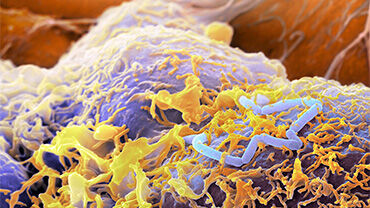Joint ECDC/EFSA annual zoonoses report publishedArchived
ECDC and EFSA have just launched the annual report on zoonoses and food-borne outbreaks in the European Union for 2009. The report shows that Salmonella cases in humans fell by 17% in 2009, marking a decrease for the fifth consecutive year. The reduction targets set by the European Commission to reduce the spread of Salmonella in poultry, particularly through eggs and chicken meat are, according to the report, likely to be the main reasons for the reduction in the number of human cases. However, Salmonella remained the most frequent cause of food-borne outbreaks and was found most frequently in chicken, turkey and pig meat.
The European Centre for Disease prevention and control (ECDC) and the European Food Safety Authority (EFSA) have just launched the annual report on zoonoses and food-borne outbreaks in the European Union for 2009. It covers 14 zoonotic diseases, including also Q fever, brucellosis, bovine tuberculosis, rabies and the two parasitic zoonoses, trichinellosis and echinococcosis. The report shows that Salmonella cases in humans fell by 17% in 2009, marking a decrease for the fifth consecutive year. The reduction targets set by the European Commission to reduce the spread of Salmonella in poultry, particularly through eggs and chicken meat are, according to the report, likely to be the main reasons for the reduction in the number of human cases. However, Salmonella remained the most frequent cause of food-borne outbreaks and was found most frequently in chicken, turkey and pig meat.
The report also states that campylobacteriosis remained the most reported zoonotic disease in humans, showing a slight increase with 198,252 cases in 2009 compared to 190,566 in 2008 (+4%). In foodstuffs, Campylobacter, which can cause diarrhoea and fever, was mostly found in raw poultry meat; and in live animals, it was found in poultry, pigs and cattle.
Listeria infections in humans showed an increase of 19% in 2009 compared to 2008, with 1,645 confirmed cases reported. Listeria is known to have a high case fatality rate, affecting mostly vulnerable groups, such as the elderly. The report estimates that in 2009 approximately 270 people died in the EU from listeriosis – a fatality rate of 17% amongst those affected by the disease. In foodstuffs, Listeria can be found in many types of ready-to-eat food, such as smoked fish and heat-treated meat products and cheeses.
Verotoxigenic Escherichia coli (VTEC) accounted for 3,573 human disease cases in 2009, marking a slight increase from 2008. Among animals and foodstuffs, VTEC was most often reported in cattle and bovine meat. The number of human cases caused by Yersinia enterocolitica, a bacterium mostly found in pigs and pig meat, fell to 7,595 in 2009.
The report says that 5,550 food-borne outbreaks were recorded in the EU in 2009, affecting 48,964 people and causing 46 deaths. The most frequently reported causes of food-borne outbreaks were Salmonella (31% of all outbreaks), viruses (19%) and bacterial toxins (10%). The biggest sources of outbreaks were eggs and egg products, mixed and buffet meals and pork and derived products.







